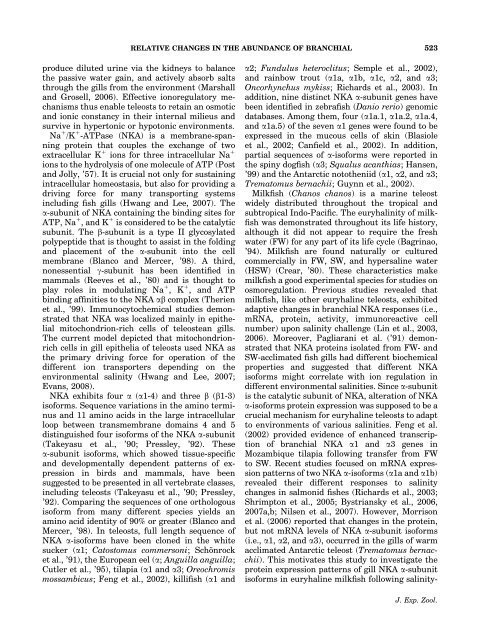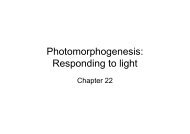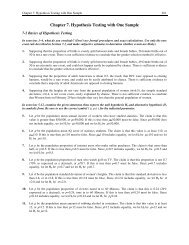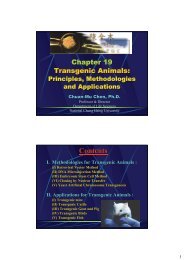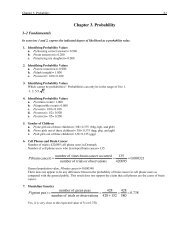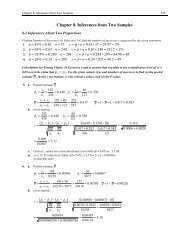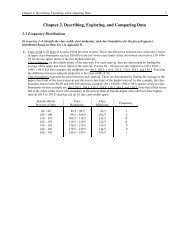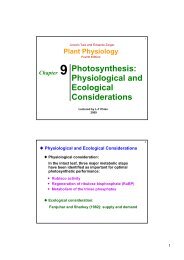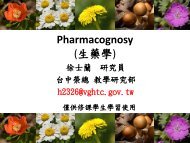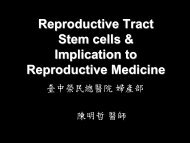isoform-like proteins in marine euryhaline milkfish (Chanos
isoform-like proteins in marine euryhaline milkfish (Chanos
isoform-like proteins in marine euryhaline milkfish (Chanos
Create successful ePaper yourself
Turn your PDF publications into a flip-book with our unique Google optimized e-Paper software.
RELATIVE CHANGES IN THE ABUNDANCE OF BRANCHIAL 523produce diluted ur<strong>in</strong>e via the kidneys to balancethe passive water ga<strong>in</strong>, and actively absorb saltsthrough the gills from the environment (Marshalland Grosell, 2006). Effective ionoregulatory mechanismsthus enable teleosts to reta<strong>in</strong> an osmoticand ionic constancy <strong>in</strong> their <strong>in</strong>ternal milieus andsurvive <strong>in</strong> hypertonic or hypotonic environments.Na 1 /K 1 -ATPase (NKA) is a membrane-spann<strong>in</strong>gprote<strong>in</strong> that couples the exchange of twoextracellular K 1 ions for three <strong>in</strong>tracellular Na 1ions to the hydrolysis of one molecule of ATP (Postand Jolly, ’57). It is crucial not only for susta<strong>in</strong><strong>in</strong>g<strong>in</strong>tracellular homeostasis, but also for provid<strong>in</strong>g adriv<strong>in</strong>g force for many transport<strong>in</strong>g systems<strong>in</strong>clud<strong>in</strong>g fish gills (Hwang and Lee, 2007). Thea-subunit of NKA conta<strong>in</strong><strong>in</strong>g the b<strong>in</strong>d<strong>in</strong>g sites forATP, Na 1 , and K 1 is considered to be the catalyticsubunit. The b-subunit is a type II glycosylatedpolypeptide that is thought to assist <strong>in</strong> the fold<strong>in</strong>gand placement of the a-subunit <strong>in</strong>to the cellmembrane (Blanco and Mercer, ’98). A third,nonessential g-subunit has been identified <strong>in</strong>mammals (Reeves et al., ’80) and is thought toplay roles <strong>in</strong> modulat<strong>in</strong>g Na 1 , K 1 , and ATPb<strong>in</strong>d<strong>in</strong>g aff<strong>in</strong>ities to the NKA ab complex (Therienet al., ’99). Immunocytochemical studies demonstratedthat NKA was localized ma<strong>in</strong>ly <strong>in</strong> epithelialmitochondrion-rich cells of teleostean gills.The current model depicted that mitochondrionrichcells <strong>in</strong> gill epithelia of teleosts used NKA asthe primary driv<strong>in</strong>g force for operation of thedifferent ion transporters depend<strong>in</strong>g on theenvironmental sal<strong>in</strong>ity (Hwang and Lee, 2007;Evans, 2008).NKA exhibits four a (a1-4) and three b (b1-3)<strong>isoform</strong>s. Sequence variations <strong>in</strong> the am<strong>in</strong>o term<strong>in</strong>usand 11 am<strong>in</strong>o acids <strong>in</strong> the large <strong>in</strong>tracellularloop between transmembrane doma<strong>in</strong>s 4 and 5dist<strong>in</strong>guished four <strong>isoform</strong>s of the NKA a-subunit(Takeyasu et al., ’90; Pressley, ’92). Thesea-subunit <strong>isoform</strong>s, which showed tissue-specificand developmentally dependent patterns of expression<strong>in</strong> birds and mammals, have beensuggested to be presented <strong>in</strong> all vertebrate classes,<strong>in</strong>clud<strong>in</strong>g teleosts (Takeyasu et al., ’90; Pressley,’92). Compar<strong>in</strong>g the sequences of one orthologous<strong>isoform</strong> from many different species yields anam<strong>in</strong>o acid identity of 90% or greater (Blanco andMercer, ’98). In teleosts, full length sequence ofNKA a-<strong>isoform</strong>s have been cloned <strong>in</strong> the whitesucker (a1; Catostomus commersoni; Schönrocket al., ’91), the European eel (a; Anguilla anguilla;Cutler et al., ’95), tilapia (a1 and a3; Oreochromismossambicus; Feng et al., 2002), killifish (a1 anda2; Fundulus heteroclitus; Semple et al., 2002),and ra<strong>in</strong>bow trout (a1a, a1b, a1c, a2, and a3;Oncorhynchus mykiss; Richards et al., 2003). Inaddition, n<strong>in</strong>e dist<strong>in</strong>ct NKA a-subunit genes havebeen identified <strong>in</strong> zebrafish (Danio rerio) genomicdatabases. Among them, four (a1a.1, a1a.2, a1a.4,and a1a.5) of the seven a1 genes were found to beexpressed <strong>in</strong> the mucous cells of sk<strong>in</strong> (Blasioleet al., 2002; Canfield et al., 2002). In addition,partial sequences of a-<strong>isoform</strong>s were reported <strong>in</strong>the sp<strong>in</strong>y dogfish (a3; Squalus acanthias; Hansen,’99) and the Antarctic nototheniid (a1, a2, and a3;Trematomus bernachii; Guynn et al., 2002).Milkfish (<strong>Chanos</strong> chanos) is a mar<strong>in</strong>e teleostwidely distributed throughout the tropical andsubtropical Indo-Pacific. The euryhal<strong>in</strong>ity of <strong>milkfish</strong>was demonstrated throughout its life history,although it did not appear to require the freshwater (FW) for any part of its life cycle (Bagr<strong>in</strong>ao,’94). Milkfish are found naturally or culturedcommercially <strong>in</strong> FW, SW, and hypersal<strong>in</strong>e water(HSW) (Crear, ’80). These characteristics make<strong>milkfish</strong> a good experimental species for studies onosmoregulation. Previous studies revealed that<strong>milkfish</strong>, <strong>like</strong> other euryhal<strong>in</strong>e teleosts, exhibitedadaptive changes <strong>in</strong> branchial NKA responses (i.e.,mRNA, prote<strong>in</strong>, activity, immunoreactive cellnumber) upon sal<strong>in</strong>ity challenge (L<strong>in</strong> et al., 2003,2006). Moreover, Pagliarani et al. (’91) demonstratedthat NKA <strong>prote<strong>in</strong>s</strong> isolated from FW- andSW-acclimated fish gills had different biochemicalproperties and suggested that different NKA<strong>isoform</strong>s might correlate with ion regulation <strong>in</strong>different environmental sal<strong>in</strong>ities. S<strong>in</strong>ce a-subunitis the catalytic subunit of NKA, alteration of NKAa-<strong>isoform</strong>s prote<strong>in</strong> expression was supposed to be acrucial mechanism for euryhal<strong>in</strong>e teleosts to adaptto environments of various sal<strong>in</strong>ities. Feng et al.(2002) provided evidence of enhanced transcriptionof branchial NKA a1 and a3 genes <strong>in</strong>Mozambique tilapia follow<strong>in</strong>g transfer from FWto SW. Recent studies focused on mRNA expressionpatterns of two NKA a-<strong>isoform</strong>s (a1a and a1b)revealed their different responses to sal<strong>in</strong>itychanges <strong>in</strong> salmonid fishes (Richards et al., 2003;Shrimpton et al., 2005; Bystriansky et al., 2006,2007a,b; Nilsen et al., 2007). However, Morrisonet al. (2006) reported that changes <strong>in</strong> the prote<strong>in</strong>,but not mRNA levels of NKA a-subunit <strong>isoform</strong>s(i.e., a1, a2, and a3), occurred <strong>in</strong> the gills of warmacclimated Antarctic teleost (Trematomus bernacchii).This motivates this study to <strong>in</strong>vestigate theprote<strong>in</strong> expression patterns of gill NKA a-subunit<strong>isoform</strong>s <strong>in</strong> euryhal<strong>in</strong>e <strong>milkfish</strong> follow<strong>in</strong>g sal<strong>in</strong>ity-J. Exp. Zool.


